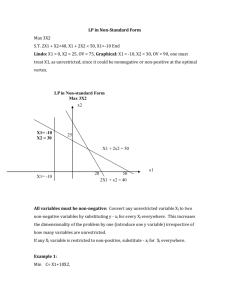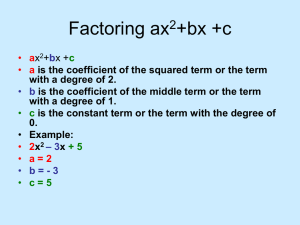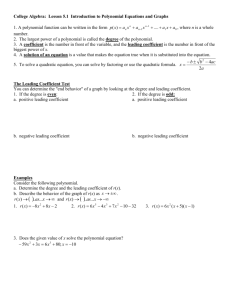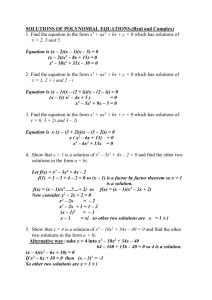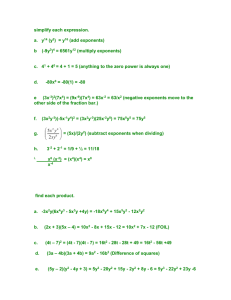Factoring A Quadratic Polynomial
advertisement
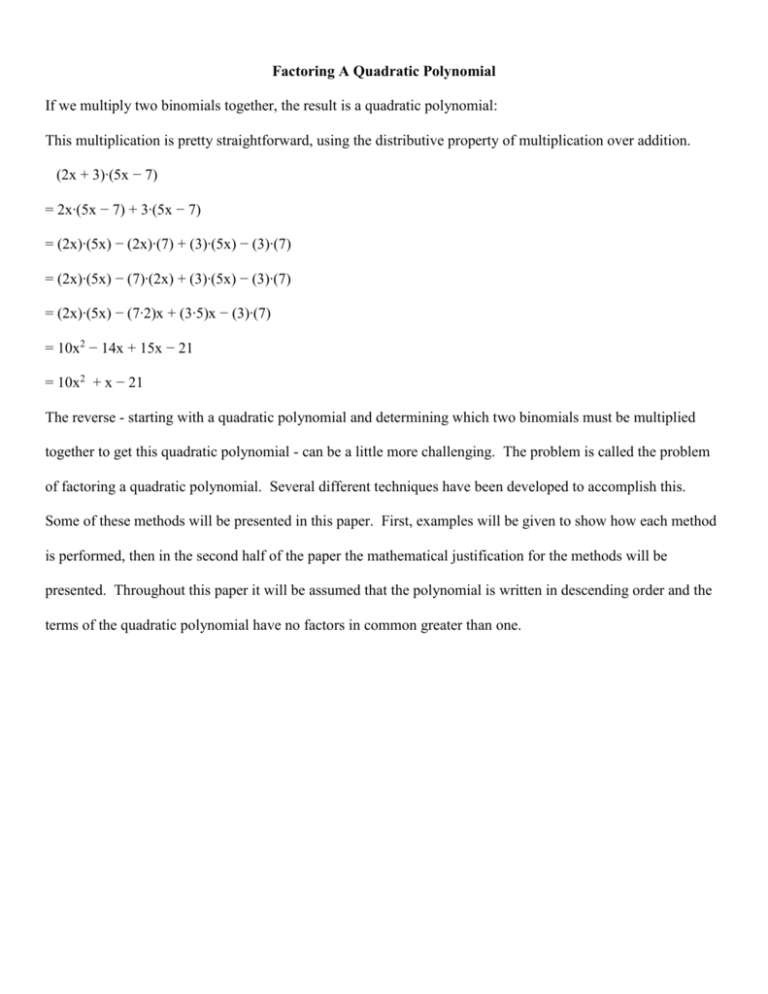
Factoring A Quadratic Polynomial If we multiply two binomials together, the result is a quadratic polynomial: This multiplication is pretty straightforward, using the distributive property of multiplication over addition. (2x + 3)∙(5x − 7) = 2x∙(5x − 7) + 3∙(5x − 7) = (2x)∙(5x) − (2x)∙(7) + (3)∙(5x) − (3)∙(7) = (2x)∙(5x) − (7)∙(2x) + (3)∙(5x) − (3)∙(7) = (2x)∙(5x) − (7∙2)x + (3∙5)x − (3)∙(7) = 10x2 − 14x + 15x − 21 = 10x2 + x − 21 The reverse - starting with a quadratic polynomial and determining which two binomials must be multiplied together to get this quadratic polynomial - can be a little more challenging. The problem is called the problem of factoring a quadratic polynomial. Several different techniques have been developed to accomplish this. Some of these methods will be presented in this paper. First, examples will be given to show how each method is performed, then in the second half of the paper the mathematical justification for the methods will be presented. Throughout this paper it will be assumed that the polynomial is written in descending order and the terms of the quadratic polynomial have no factors in common greater than one. I. Factoring by grouping: In this method, we literally reverse the multiplication process, step by step. In doing this, the trick is to figure out how to split the middle term into the correct two terms, −14x and 15x in the multiplication shown above. Steps 1-4 shown below allow us to do this. Problem: Factor 10x2 + x − 21. Solution: 1. Multiply the leading coefficient by the constant term. (Note that the resulting product, −210, has as its factors all the factors of the leading term and the constant term.) 10∙(−21) = −210 2. Write all pairs of factors that multiply to get the product in step 1. 1∙(−210) 2∙(−105) 3∙(−70) 5∙(−42) 6∙(−35) 7∙(−30) 10∙(−21) 14∙(−15) −1∙210 −2∙105 −3∙70 −5∙42 −6∙35 −7∙30 −10∙21 −14∙15 3. Search the list of pairs for a pair that adds up to the middle term coefficient of the quadratic polynomial. (Such a pair must exist if the quadratic can be factored, since each of the two terms that are added to get the middle term is the product of factors of the coefficient of the leading term and factors of the constant term. If no pair can be found that adds up to the middle term coefficient, the quadratic is prime, i.e., it cannot be factored into the product of two binomials having integer coefficients.) 1∙(−210) 2∙(−105) 3∙(−70) 5∙(−42) 6∙(−35) 7∙(−30) 10∙(−21) 14∙(−15) −1∙210 −2∙105 −3∙70 −5∙42 −6∙35 −7∙30 −10∙21 −14∙15 −14 + 15 = 1 4. Rewrite the middle term using the two numbers found in step 3. 10x2 + x − 21 = 10x2 − 14x + 15x − 21 5. Group the first two terms together and group the second two terms together. 10x2 − 14x + 15x − 21 = (10x2 − 14x) + (15x − 21) 6. Factor the greatest common factor out of the first two terms, and do the same for the second two terms. (10x2 − 14x) + (15x − 21) = 2x(5x − 7) + 3(5x − 7) 7. The expressions in parentheses in each of the two terms will (always) be identical and are therefore a common factor for the terms. Factor it out of the two terms, and the factoring is complete. 2x(5x − 7) + 3(5x − 7) = (2x + 3)(5x − 7) II. Factoring by (educated) guessing (aka, factoring by groping): Problem: Factor 10x2 + x − 21. Solution: 1. Write all pairs of factors that multiply to get the leading term coefficient; then write all pairs of factors that multiply to get the constant term. 10 −21 1∙10 −1∙21 2∙5 −3∙7 1∙(−21) 3∙(−7) 2. Try these pairs to see which combination produces the correct factorization. The numbers in the first set of pairs are used as the coefficients of x in the factors and the numbers in the second set of pairs are used as the constant terms of the factors. (1∙x − 1)∙(10∙x + 21) = 10x2 + 11x − 21 (10∙x − 1)∙(1∙x + 21) = 10x2 + 209x − 21 (1∙x − 3)∙(10∙x + 7) = 10x2 − 23x − 21 (10∙x − 3)∙(1∙x + 7) = 10x2 + 67x − 21 (2∙x − 1)∙(5∙x + 21) = 10x2 + 37x − 21 (5∙x − 1)∙(2∙x + 21) = 10x2 + 103x − 21 (2∙x − 3)∙(5∙x + 7) = 10x2 − 1x − 21 (5∙x − 3)∙(2∙x + 7) = 10x2 + 29x − 21 (1∙x + 1)∙(10∙x − 21) = 10x2 − 11x − 21 (10∙x + 1)∙(1∙x − 21) = 10x2 − 209x − 21 (1∙x + 3)∙(10∙x − 7) = 10x2 + 23x − 21 (10∙x + 3)∙(1∙x − 7) = 10x2 − 67x − 21 (2∙x + 1)∙(5∙x − 21) = 10x2 − 37x − 21 (5∙x + 1)∙(2∙x − 21) = 10x2 − 103x − 21 (2∙x + 3)∙(5∙x − 7) = 10x2 + 1x − 21 (5∙x + 3)∙(2∙x − 7) = 10x2 − 29x − 21 III. Factoring by the (slightly modified) "Slip and slide" method: Problem: Factor 10x2 + x − 21. Solution: 1. Multiply and divide the quadratic polynomial by the leading coefficient. (10)(10x2 + x − 21) 10 100x2 + 10x − 210 10 = 2. Let u equal the product of the leading coefficient times x . Substitute this into the polynomial in step 1. 10x = u, 100x2 = u2 100x2 + x − 210 10 = u2 + u − 210 10 3. Factor this new polynomial using factoring by groping. This is pretty easy to do, since the leading coefficient is 1. 1 −210 1∙1 −1∙210 −2∙105 u2 + u − 210 = (u + 15)(u − 14) −3∙70 10 10 −5∙42 −6∙35 −7∙30 −10∙21 −14∙15 4. Reverse the substitution made in step 2, i.e., replace u with the product of the leading coefficient times x . (u + 15)(u − 14) 10 = (10x + 15)(10x − 14) 10 5. Factor out the greatest common factor from each of the two factors in step 4. (10x + 15)(10x − 14) 10 = 5(2x + 3)(5x − 7)2 10 6. Multiply the two greatest common factors from step 5 together. This product will (always) be equal to the leading coefficient. Cancel this product with the leading coefficient in the denominator. What remains is the desired factorization. 5(2x + 3)(5x − 7)2 10 = 5∙2(2x + 3)(5x − 7) 10 = 10(2x + 3)(5x − 7) 10 = (2x + 3)(5x − 7)

